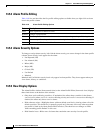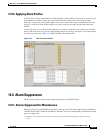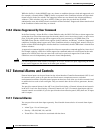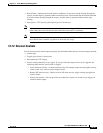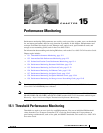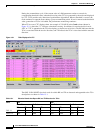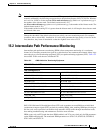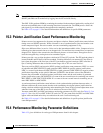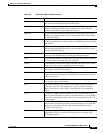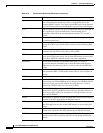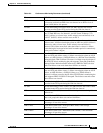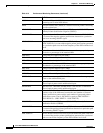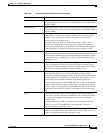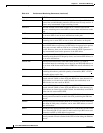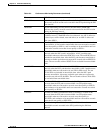
15-4
Cisco ONS 15454 Reference Manual, R7.0
78-17191-01
Chapter 15 Performance Monitoring
15.3 15.3 Pointer Justification Count Performance Monitoring
Note Far-end IPPM is not supported by all OC-N cards. It is supported by OC3-4 and EC-1 cards. However,
SONET path PMs can be monitored by logging into the far-end node directly.
The ONS 15454 performs IPPM by examining the overhead in the monitored path and by reading all of
the near-end path PM values in the incoming direction of transmission. The IPPM process allows the
path signal to pass bidirectionally through the node completely unaltered.
See Table 15-3 on page 15-5 for detailed information and definitions of specific IPPM parameters.
15.3 Pointer Justification Count Performance Monitoring
Pointers are used to compensate for frequency and phase variations. Pointer justification counts indicate
timing errors on SONET networks. When a network is out of synchronization, jitter and wander occur
on the transported signal. Excessive wander can cause terminating equipment to slip.
Slips cause different effects in service. Voice service has intermittent audible clicks. Compressed voice
technology has short transmission errors or dropped calls. Fax machines lose scanned lines or experience
dropped calls. Digital video transmission has distorted pictures or frozen frames. Encryption service
loses the encryption key, causing data to be transmitted again.
Pointers provide a way to align the phase variations in STS and VT payloads. The STS payload pointer is
located in the H1 and H2 bytes of the line overhead. Clocking differences are measured by the offset in
bytes from the pointer to the first byte of the STS synchronous payload envelope (SPE) called the J1
byte. Clocking differences that exceed the normal range of 0 to 782 can cause data loss.
There are positive (PPJC) and negative (NPJC) pointer justification count parameters. PPJC is a count
of path-detected (PPJC-PDET-P) or path-generated (PPJC-PGEN-P) positive pointer justifications.
NPJC is a count of path-detected (NPJC-PDET-P) or path-generated (NPJC-PGEN-P) negative pointer
justifications depending on the specific PM name. PJCDIFF is the absolute value of the difference
between the total number of detected pointer justification counts and the total number of generated
pointer justification counts. PJCS-PDET-P is a count of the one-second intervals containing one or more
PPJC-PDET or NPJC-PDET. PJCS-PGEN-P is a count of the one-second intervals containing one or
more PPJC-PGEN or NPJC-PGEN.
A consistent pointer justification count indicates clock synchronization problems between nodes. A
difference between the counts means that the node transmitting the original pointer justification has
timing variations with the node detecting and transmitting this count. Positive pointer adjustments occur
when the frame rate of the SPE is too slow in relation to the rate of the STS-1.
You must enable PPJC and NPJC performance monitoring parameters for LTE cards. See Table 15-2 on
page 15-3 for a list of Cisco ONS 15454 LTE cards. In CTC, the count fields for PPJC and NPJC PMs
appear white and blank unless they are enabled on the card view Provisioning tab.
See Table 15-3 on page 15-5 for detailed information and definitions of specific pointer justification
count PM parameters.
15.4 Performance Monitoring Parameter Definitions
Table 15-3 gives definitions for each type of PM parameter found in this chapter.



